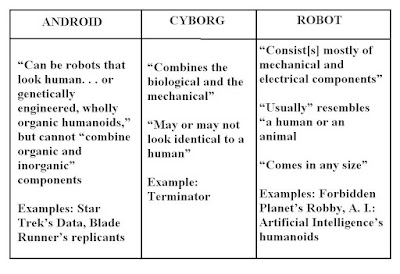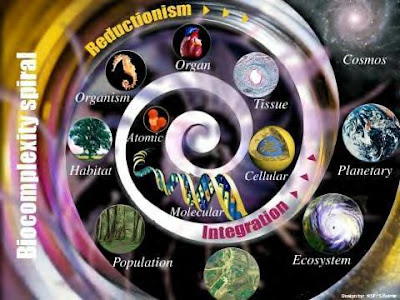copyright 2008 by Gary L. Pullman
 In science fiction, humanoid robots were once all androids, albeit without the specific parts that, among humans (and plants and animals), make a body male. In more recent years, as women increasingly enter the ranks of science fiction writers, factories have begun to offer feminine, if not actually female, versions of cyborgs, robots, and other servo-mechanisms of humanoid appearance. Known as fembots or gynoids, these models, like the androids, feature secondary, rather than primary, sexual characteristics, their anatomical curves distinguishing them from their more angular android brothers. However, the ways these feminine humanoids see and interact with the world, including how they converse with others, also often distinguishes them from their masculine counterparts.
In science fiction, humanoid robots were once all androids, albeit without the specific parts that, among humans (and plants and animals), make a body male. In more recent years, as women increasingly enter the ranks of science fiction writers, factories have begun to offer feminine, if not actually female, versions of cyborgs, robots, and other servo-mechanisms of humanoid appearance. Known as fembots or gynoids, these models, like the androids, feature secondary, rather than primary, sexual characteristics, their anatomical curves distinguishing them from their more angular android brothers. However, the ways these feminine humanoids see and interact with the world, including how they converse with others, also often distinguishes them from their masculine counterparts.

A relatively recent book informs us of the true origins of men and women. The former are from Mars, it claims, the latter, from Venus. The book’s origins of the sexes derive, possibly, from the biological signs for male and female. The sign for males is the familiar circle out of the upper right arc of which projects something that looks like an arrow but is supposed to be a spear, just as the circle represents a shield, characterizing men as warriors, belonging to the cult of Ares, or Mars, the god of war. The sign for females is the equally familiar circle from which is suspended, from the nadir of its lower arc, a cross, the whole representing the hand-mirror of the goddess of love, Venus, or Aphrodite. Venus, the symbol seems to suggest, thy name is vanity.

Man, the warrior, and woman, the toilette aficionado--these are the images that correspond to those of the sexes, and, if the work of Deborah Tannen and various sociologists and psychologists is correct, scientific evidence may bear out these rather sexist conceptions of sex and gender, Supergirl, Wonder Woman, Buffy the Vampire Slayer, and Xena, the Warrior Princess, notwithstanding.
By knowing the differences in the ways that men and women communicate, a writer may realistically portray conversations between same-sex and opposite-sex male and female characters realistically. In addition, when dramatic situations in which men and women are the speakers occur, these differences in the way that they communicate can lead to the essence of plot itself, story conflict.
According to Tannen’s essay, “Sex, Lies, and Conversation,” boys and girls segregate themselves as youths, boys keeping company with other boys and girls keeping company with other girls. Therefore, separately, the members of each sex teach one another (and, therefore, the men or women that they later become) how to communicate. Viva la difference!
Boys’ groups, Tannen says, are larger and more inclusive than girls’ groups. They’re also hierarchical, with an underdog and a top dog, and conversation among the members of the all-male group tends to be “agonistic,” or warlike, peppered with “ritual challenges.” Conversation is akin to debate, with one boy confronting his fellow with counterarguments. If one of them raises a personal problem as a topic of conversation, his peers are likely to dismiss it as being less important than it seems. Speakers sit “at angles to each other,” only occasionally “glancing at each other,” and leap from topic to topic, rather than focusing for long on any one subject. In public, the males of the species speak to show their knowledge and to fend off the verbal attacks of their peers. However, they don’t like to listen, for, as a holdover from their boyhood days in hierarchical groups, they feel that listening, a seemingly passive role, makes them subordinate to speakers, who play a more apparently active role. They attend silently to the words of others. At home, having nothing to prove and no one to fend off, men tend to speak much less. For them, relationships are based on their relative statuses within the group, and the cement that binds them together is participatory activity, or “doing things together.”
Girls’ groups, Tannen says, are smaller, less inclusive, and more democratic, with members being regarded as equals rather than as greater or lesser subordinates assembled under the authority of a top dog. Their conversation is more sympathetic, intended to “establish rapport.” Rather than confronting a peer with counterarguments, girls are more likely to suggest alternative thoughts, often in the form of non-threatening, or helpful, questions. Personal problems, as topics of feminine conversation, elicit sympathy and solidarity from listeners. Girls maintain almost constant eye contact, looking at one another’s faces directly, and they tend to stay on the same topic for much of their conversation. To indicate that they are listening, girls (and women) often nod their heads and make “listening noises.” In public, afraid that they may offend someone, “spark disagreement, or appear to be showing off,” women tend to speak less, but at home, they are more comfortable in expressing their views, and tend to speak more. For them relationships are founded upon intimacy, and the cement that binds them together is talking.
Knowing these communication secrets of the sexes, writers can portray them realistically as their characters engage in dialogue, but authors can also capitalize upon the misunderstandings and misinterpretations among men and women regarding one another’s conversational behavior, turning these misimpressions into story conflict.
Women, unaware of how and why men listen as they do, believe that men don’t listen to them. Men, misinterpreting women’s “listening noise” as “overreaction or impatience,” consider women overly sensitive or rude. Preferring to hear alternative views expressed as questions rather than as counterarguments, women think men who challenge them directly with other points of view are disloyal, while men believe women simply don’t want to hear any views that differ from their own. Seeing that men are voluble enough in public, women may suppose that their reticence at home shows that their husbands are uninterested in them as conversation partners and that their relationship has become less intimate and may fail. Men may wish that their wives would be more supportive of them in their public stances toward political issues or on current events. Changing the topic, especially when, in doing so, a man involves himself as the new subject of conversation, may make women think that men are indifferent to the woman’s topic and are egoistic. Men may suppose women to be obsessed with a topic and, perhaps, at times, to be narrow minded. Tannen points out that half of marriages end in divorce and that, often, from the woman’s point of view, the cause of the failure of the marriage is “a lack of communication.” Other consequences of these differences in conversational style and technique are that men are often considered insensitive and women as no being assertive enough.
In Erin Brockovich, the protagonist is motivated, at the beginning of the movie, more by her desire to feed and clothe her children than she is by solving a case she uncovers concerning the damage to the health of a community’s residents that a power company’s illicit dumping of a dangerous chemical into the local water supply has caused. She wants the job as an attorney’s legal assistant so she can pay her bills and provide for her children‘s welfare. Later, when she is fired, she uses the facts that she has uncovered about the case as leverage to get her job back, along with a sizeable raise, because, again, as she tells her boss, “I have bills to pay.” Once she is on the case, however, she is dogged in her determination to see that the company does the right thing, paying for its abuses of the residents and the environment. Perhaps it is because she is a mother, concerned with nurturing her children, that she finds the power company’s deeds as reprehensible as she does, for their illegal abuse of the environment is, for her, not only criminal but immoral. It has hurt people, including children. As a woman, she uses investigative techniques that are unavailable to men. When her boss asks her how she expects to gain admittance to the state’s public records concerning the chemicals involved in the case, she replies, “They’re called boobs, Ed.” Erin is quick to accuse her boss of cheating her and of not knowing how to apologize, but, at the end of the film, he increases her share of the money the law firm has won in prosecuting the case, leaving her speechless, before he tells her that she “sucks” at apologizing, just as she had previously told him.
Although Erin Brockovich is not a horror story--at least, not in the same sense as The Toxic Avenger--it capitalizes on the differences in how men and women perceive the world and their respective places in it and on the way that these differences in perception guide and motivate their behavior, including the ways that they speak and listen or, in a word, communicate. Other stories that also capitalize on these differences include Buffy the Vampire Slayer, Xena: Warrior Princess, and, to a lesser extent, Supergirl and Wonder Woman, mostly, in these instances, by the mechanism of role reversal. In the Buffy series, for example, the female characters are empowered and the male characters are, well, emasculated, as it were, although, in their respective conversational styles and techniques, they continue to be the men and women that the boys and girls inside them created them to be. In this regard, at least, in even the eunuch, Mars rules the man.

















